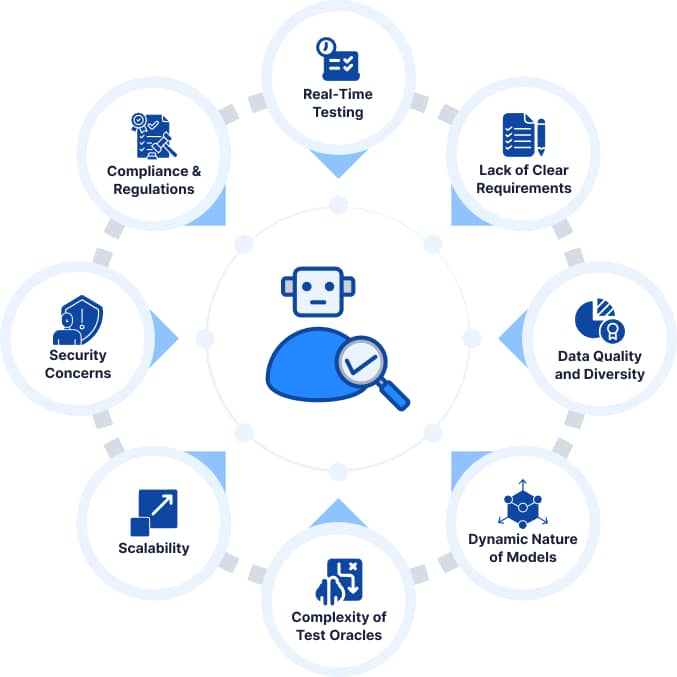- Why 2026 Is a Turning Point for QA and Software Quality
- The Evolution of Testing: Manual → Automated → Autonomous
- AI & ML in Software Testing: The Technologies Powering the Shift
- The New AI-Powered QA Workflow: Faster, Smarter, Predictive
- Shift-Left + Shift-Right: The Hybrid QA Strategy That Wins in 2026
- The Rise of Crowd Testing: Real-World Quality at Scale
- The New QA Role in 2026: From Tester to Quality Strategist
- Challenges of AI-Driven Autonomous Testing (And How To Solve Them)
- Quality as a Business Metric: The Shift Every Enterprise Must Make
- What QA Looks Like in 2026 and Beyond
- Final Thoughts: The Future of QA Belongs to AI-First Teams
Quality Assurance (QA) is no longer just a back-office function; it is quickly becoming a strategic leveler for businesses. According to the Capgemini World Quality Report 2024, 72% of organizations increased QA budgets to adopt AI-driven testing, highlighting the industry-wide shift toward intelligent, automated solutions. As software systems grow more complex and release cycles accelerate, AI and Machine Learning (ML) are redefining what quality means and how it is achieved.
In 2026, QA will not merely be about catching bugs. It will shape the way companies deliver products, engage customers, and maintain operational resilience. Teams that embrace AI-first QA strategies will not only reduce errors but also drive business outcomes, ensuring every digital interaction meets real-world expectations.
Why 2026 Is a Turning Point for QA and Software Quality
From back-office task to core business strategy
QA has long been perceived as a support function, focused on preventing mistakes. Today, enterprises are realizing that software quality directly impacts customer trust, revenue, and brand reputation. AI and ML bring intelligence into testing, turning QA from a cost center into a strategic capability that informs product decisions and operational planning.
Modern QA integrates testing with analytics, continuous feedback loops, and predictive insights. By 2026, QA will influence not just code quality but also UX, uptime, accessibility, and security, making it central to business strategy rather than a post-development checkpoint.
Why enterprises are betting big on AI-first QA
AI-first QA allows companies to optimize resources and accelerate release cycles without compromising quality. Intelligent systems can autonomously generate test cases, predict defects, and prioritize high-risk scenarios, enabling testers to focus on exploratory testing and critical thinking. With the rise of complex architectures like microservices and distributed systems, AI-driven QA becomes indispensable.
Early adopters are seeing tangible benefits, from reduced downtime to improved customer experience. By leveraging AI, organizations can simulate diverse user journeys, analyze historical failure patterns, and maintain test suites dynamically: all without increasing manual effort.
The market forces pushing QA into a new era
Several market forces are accelerating the adoption of AI-driven QA. Agile and DevOps practices demand rapid delivery, while cloud-native applications introduce layers of complexity that traditional testing cannot address. Regulatory requirements, especially with the EU AI Act expected in 2026, are pushing QA teams to adopt systematic, auditable approaches.
The convergence of these factors makes 2026 a turning point: QA is no longer optional but a critical differentiator for enterprises seeking agility, resilience, and customer satisfaction.
The Evolution of Testing: Manual → Automated → Autonomous
Limitations of traditional and automated testing
Manual testing, while flexible, is slow, error-prone, and difficult to scale. Automated testing improved speed and repeatability but introduced maintenance challenges as test scripts broke with every UI or code change. Traditional testing often fails to catch nuanced defects, especially in complex or highly dynamic systems.
These limitations highlight the need for smarter approaches. As software complexity grows, QA teams cannot rely solely on human effort or static automation. A more adaptive, intelligent solution is required to ensure reliability and coverage.
How AI filled the gap leading to self-healing and self-optimizing tests
AI bridges these gaps by enabling self-healing automation, predictive defect detection, and intelligent test prioritization. Machine learning algorithms analyze historical data to anticipate failure-prone areas, while natural language processing (NLP) can convert user stories into executable test scripts.
Self-optimizing tests adjust automatically to changes in the UI or underlying code, reducing maintenance and ensuring consistent coverage. This allows QA teams to focus on high-value tasks rather than repetitive upkeep, increasing overall productivity and confidence in releases.
What fully autonomous testing really means in 2026
By 2026, fully autonomous QA testing will involve AI-driven systems executing, monitoring, and learning from every test cycle. These systems will autonomously determine which scenarios to test, adapt to environmental changes, and predict potential failures. Human oversight remains essential, but testers will act as strategists and supervisors rather than executors of routine tasks.
Autonomous QA will integrate seamlessly with CI/CD pipelines, enabling continuous validation, faster releases, and minimal downtime. This approach represents a shift from QA as a checkpoint to QA as an ongoing, intelligent process embedded in every stage of development.
AI & ML in Software Testing: The Technologies Powering the Shift
AI-driven test case generation and requirement analysis
AI can automatically generate test cases based on requirements, historical defects, and user behavior. NLP models interpret plain-language specifications and convert them into structured tests, eliminating ambiguity and reducing human error. This accelerates the testing lifecycle and ensures that critical scenarios are always covered.
These tools also analyze requirement changes and adjust test cases accordingly, maintaining alignment with evolving product specifications. By removing bottlenecks in test creation, AI accelerates both development and QA cycles.
Machine learning models for predictive defect detection
ML algorithms can identify components most likely to fail by analyzing past defects, code commits, and usage patterns. Predictive defect detection allows QA teams to focus efforts on high-risk areas, improving efficiency and reducing the likelihood of critical failures in production.
Predictive analytics also informs resource allocation, ensuring that testing priorities align with business impact and user experience goals, making QA a more strategic function.
NLP-powered test scripts and code intelligence
Natural language processing enables test scripts to be created and maintained with minimal human coding. AI systems understand intent from user stories, translate it into executable test steps, and even suggest optimizations. Code intelligence also helps identify redundant or obsolete tests, further streamlining maintenance.
This capability allows non-technical stakeholders, like product managers or UX designers, to participate in QA workflows, democratizing quality and aligning teams around shared objectives.
Generative QA copilots within CI/CD pipelines
Generative AI copilots can autonomously draft test scenarios, predict potential failures, and recommend fixes directly within CI/CD pipelines. These AI copilots continuously learn from each test run, improving coverage, reducing false positives, and accelerating release confidence.
By integrating with CI/CD workflows, AI ensures that every deployment meets quality standards without slowing delivery cycles. It transforms QA from a post-development activity to a real-time, strategic function.
Self-healing automation for dynamic UI and microservices apps
Dynamic UIs and microservices architectures frequently break traditional automation scripts. Self-healing automation detects these changes and adapts test scripts in real-time. AI-driven maintenance reduces human intervention, keeps tests relevant, and prevents delays in release schedules.
This capability is particularly important for modern applications that undergo frequent updates or are deployed across multiple environments.
The New AI-Powered QA Workflow: Faster, Smarter, Predictive

AI-driven systems execute tests across multiple environments, browsers, and devices simultaneously. This multi-platform coverage ensures consistent quality and accelerates release cycles. Autonomous execution eliminates bottlenecks associated with manual or semi-automated testing.
By running parallel tests and analyzing results in real-time, AI allows teams to detect critical defects early and prevent production issues.
When failures occur, AI systems perform intelligent root cause analysis by correlating logs, metrics, and historical patterns. This reduces time-to-resolution and provides actionable insights to developers and QA teams.
Predictive debugging capabilities allow teams to proactively address defects before they impact users, ensuring a resilient and reliable software environment.
AI evaluates risk in real-time, factoring in defect probability, user impact, and business priorities. Deployment decisions are informed by predictive analytics, ensuring releases are safe and high-quality. This approach enables confident, data-driven release management, reducing downtime and operational risk.
AI automatically recommends tests based on code churn, user interactions, and previous failures. It eliminates redundant tests and adapts to code or UI changes, minimizing maintenance. Increased test coverage ensures better product reliability and improved user satisfaction without overburdening QA teams.
Shift-Left + Shift-Right: The Hybrid QA Strategy That Wins in 2026
Why early defect prevention still matters
Shift-left testing ensures defects are caught early, during design and planning phases. Fixing bugs early is significantly cheaper and reduces downstream risks. AI augments shift-left by predicting high-risk components and automatically generating preventive tests.
Shift-right validation with real-time production monitoring
Shift-right testing validates software in production, observing real user interactions to catch unforeseen issues. AI-powered monitoring enables continuous validation and performance checks, ensuring reliability and optimizing user experience in real time.
2026 is the rise of the hybrid model across DevOps teams
Combining shift-left and shift-right provides comprehensive coverage. Gartner’s 2023 and 2025 reports predicted that by 2026, 40% of enterprise applications will have task-specific AI agents performing complex tasks autonomously. This reflects a shift toward AI-driven DevOps workflows, supporting smarter, more predictive QA without implying fully autonomous testing.
The Rise of Crowd Testing: Real-World Quality at Scale
Why in-house testing labs are no longer enough
Modern applications must work across a vast array of devices, OS versions, and network conditions. Traditional in-house labs are insufficient to replicate this diversity. Crowd testing leverages global testers and real devices to validate real-world performance, providing more accurate results.
Real-user validation across devices, geographies, and networks
Crowd testing enables testing under realistic conditions, covering variations in device types, connectivity, and usage patterns. This approach identifies edge-case failures and ensures quality across all potential user scenarios.
Crowd testing as a core part of QA strategy by late 2026
By late 2026, crowd testing will become integral to QA workflows. AI-assisted tools can manage distributed testers, aggregate feedback, and integrate results with CI/CD pipelines, ensuring comprehensive validation at scale.
The New QA Role in 2026: From Tester to Quality Strategist
QA professionals must now understand AI/ML systems, cloud-native architectures, and cybersecurity principles. These skills enable them to design intelligent tests, interpret AI-driven insights, and secure software against modern threats.
The roles of Quality Engineer and QA Strategist are emerging as pivotal. They oversee AI tools, validate outputs, and align testing with business objectives. These positions combine technical expertise with strategic thinking, bridging QA and product strategy.
Human testers focus on exploratory testing, ethics, and context-driven decisions, while AI handles repetitive, predictive, and maintenance tasks. This collaboration creates a faster, smarter, and more reliable QA process, elevating software quality across the board.
Challenges of AI-Driven Autonomous Testing (And How To Solve Them)

- Integrating AI/ML into existing QA workflows: Introducing AI into legacy workflows requires careful planning, API integration, and training. Incremental adoption and pilot programs help teams adapt without disrupting delivery pipelines.
- Handling dynamic UIs and fast-changing applications: Self-healing automation mitigates issues caused by UI changes. Continuous model updates and adaptive scripts ensure tests remain accurate despite frequent application updates.
- Test data management and ML model accuracy: High-quality, diverse data is essential for AI/ML models. Synthetic and anonymized data generation can address privacy and volume requirements, improving model reliability.
- Managing false positives and interpreting AI results: AI models may flag irrelevant issues initially. Regular validation, threshold tuning, and human oversight minimize false positives and ensure actionable outputs.
- ROI, cost justification, and organizational resistance: Investing in AI-first QA requires business buy-in. Demonstrating faster release cycles, reduced defects, and improved customer satisfaction helps justify budgets and overcome resistance.
Quality as a Business Metric: The Shift Every Enterprise Must Make
- Linking uptime, performance, and CX to QA outcomes: Software quality directly affects customer satisfaction, retention, and revenue. AI-driven QA allows teams to measure quality metrics such as uptime, responsiveness, and accessibility, linking them to tangible business outcomes.
- Regulatory-ready QA (especially with AI Act in 2026): AI-based QA tools ensure traceability, compliance, and audit readiness, critical for regulatory frameworks like the EU AI Act. Documentation of AI decisions and test coverage will be essential for compliance.
- Security validation as a non-negotiable layer of testing: Cybersecurity is now integral to QA. Automated vulnerability scanning, secure code analysis, and AI-powered anomaly detection reduce risks and ensure robust, compliant software releases.
What QA Looks Like in 2026 and Beyond
AI won’t replace testers, it amplifies their impact. By handling repetitive tasks, predicting potential failures, and delivering actionable insights, AI allows testers to focus on strategic, high-value work.
Autonomous testing cycles will continuously execute, monitor, and optimize, requiring minimal human intervention while ensuring faster releases, broader coverage, and lower operational risk.
Quality assurance will need to be integrated at every stage of software development. Organizations that build a culture of continuous quality, embed AI throughout workflows, and enable seamless human-AI collaboration will set the benchmark for product reliability and exceptional user experiences.
Final Thoughts: The Future of QA Belongs to AI-First Teams!
The message is clear: QA isn’t becoming obsolete, it’s becoming more powerful than ever. AI and ML are transforming how teams test, ship, and scale software, enabling smarter defect prediction, faster root-cause analysis, and self-healing automation. Companies that adopt AI-first QA will deliver higher-quality products, respond quickly to issues, and ensure world-class user experiences.
At Helius Work, we make it easier to integrate autonomous testing, predictive analytics, and continuous quality monitoring into your workflow. By leveraging these tools, teams can focus on innovation while maintaining confidence in every release. Helius Work supports next-gen QA workflows. The future of QA belongs to teams that evolve; those who embrace AI now will lead the quality game in 2026 and beyond.



